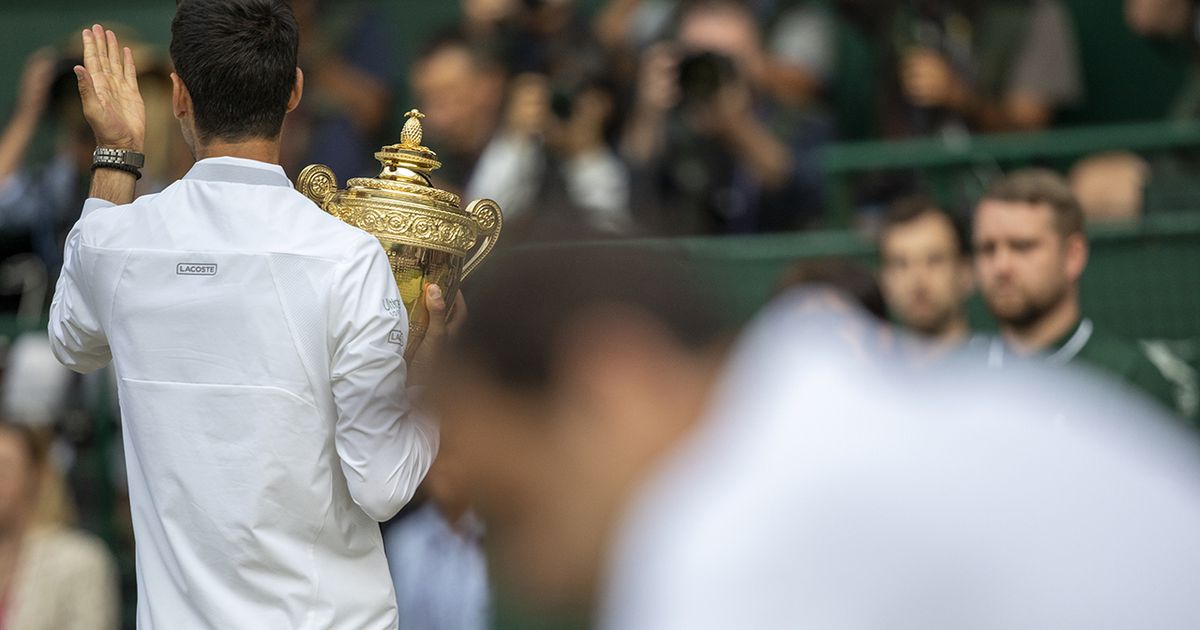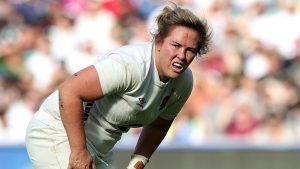Have Djokovic, Federer, and Nadal made this the greatest era in men’s tennis history?


There’s not much to debate on that question, though there is plenty to appreciate in the wake of Novak Djokovic’s epic victory over Roger Federer in an all-time Wimbledon classic on Sunday.
Hopefully you abandoned plans to clean out the garage, mow the lawn or fix the toaster and instead spent a fair chunk of Sunday watching the final, a five-set, five-hour marathon that might have lasted into eternity had new rules not called for a tiebreak at 12-12 in the deciding set.
There was room on Centre Court for only Djokovic and Federer on Sunday, but they share the men’s tennis stage spotlight with Rafael Nadal, who was taken out by Federer in the semifinals. What the Big Three is producing right now, towards what is supposed to be the twilight of their imperious reign, is beyond compare. And it is not even close. When Djokovic hoisted the Wimbledon trophy, it marked the 54th Grand Slam title collected by the Big Three. Think about that for a moment. With four per year, they have collectively amassed 13.5 years’ worth of Slams. That’s nearly a lifetime for Coco Gauff.
They’re getting old (Fed is 37) but they’re somehow getting better — and the gap between the Big Three and the field is growing.
The world Nos. 4, 5 and 6 are Dominic Thiem, Alexander Zverev and Stefanos Tsitsipas. They all lost in the opening round. Nearly two weeks later, Federer outdueled Nadal in the semifinal, then waged grass court warfare against Djokovic.
Amazing match well deserved win by @rogerfederer I had some chances but… Roger played better. Good luck for the final @Wimbledon 2019. Thanks all for the support. Always fantastic to be here. See you next year! ?
— Rafa Nadal (@RafaelNadal) July 12, 2019
Between them, Federer, Nadal and Djokovic have won every single one of the last 11 Slams, right around the time they’re supposed to be past their best. That streak would be even more remarkably impressive if not for the fact that the trio once reeled off 18 straight majors without giving anyone else a look in. Then, when that run was broken by Juan Martin del Potro in 2009, they went on to win another 11 straight.
“This generation is incredible,” Pete Sampras told USA TODAY way back in 2012. “We are probably going to have three players winning double-digit majors.”
Yep, and they didn’t stop there.
We have seen great eras in tennis before, but this is on a different level. There is always a certain recency bias when it comes to ascertaining greatness, but this isn’t even a particularly recent era. It is an old one that just forgot to stop. Federer won his first major in 2003, Nadal in 2005 and Djokovic in 2008.
“These guys are the ones pushing the game forward,” commentator Patrick McEnroe told ESPN. “They’re out there taking it to a new level, even at this point in their careers.”
Past collections of men’s champions should absolutely be loved, admired, and fondly remembered. But they can’t hold a candle to this group.
The year is 2059. The top three tennis players in the world are Novak Djokovic, Roger Federer and Rafael Nadal. #WimbledonFinal pic.twitter.com/frprjBAiav
— Ben Thompson (@BenThommo98) July 14, 2019
The time of Bjorn Borg, John McEnroe and Jimmy Connors was wonderfully enthralling and made tennis big box office around the world. You couldn’t beat it for drama and panache, a special soap opera lit up by the different personalities of its primary protagonists.
There was Sampras/Andre Agassi/Jim Courier’s run, the last moment when the United States could truly consider itself the ultimate powerhouse in men’s tennis. Sampras’ stylish flow was unmistakable, Agassi’s freakish talent awe-inspiring and Courier’s iron will deserving of the utmost respect. Great times.
But consider this. Borg won 11 Slams in his career; Djokovic has won 10 of them in just the last five years, and his 16 overall titles still lag behind Federer’s 20 and Nadal’s 18. McEnroe’s seven majors put him seventh on the all-time Open era list. Djokovic has won seven times too – if you only count the Australian Open. Connors accumulated eight majors all told; Federer has eight at Wimbledon alone.
Five #Wimbledon crowns, won within a single decade.
An all-time great. @DjokerNole ? pic.twitter.com/A7HhCJ42CH
— Wimbledon (@Wimbledon) July 15, 2019
And if we’re talking single-event dominance, the most absurd number of all is Nadal’s haul of 12 French Opens. Even if he had never won another Slam, the Spaniard would be just two behind Sampras, whose 14 Slam titles was formerly the most ever until these three all usurped him.
A year – and four combined Slams — ago, former world No. 4 Tim Henman told Sky Sports: “It is perhaps the greatest era. When you think they have won 50 Slams between them, I don’t think that has happened in any other era.”
It hasn’t. In fact, the Big Three’s 54 major championships is more than the hauls of Borg/McEnroe/Connors (26) and Sampras/Agassi/Courier (26) combined. Also consider that Federer/Nadal/Djokovic combined have finished runner-up in Slams 28 times – with 20 of those losses in a head-to-head finals matchup against a fellow member of the Big Three.
Since Federer’s first Slam title in 2003, the Big Three have won 54 of the 65 major titles. They play a different game to everyone else. They make the absurdly difficult look routine. Obviously, no one can live with them when they’re at their peak.
The problem for the pack is, they can’t beat them when they’re at their regular level either. And they don’t believe they can.
After his victory, Djokovic cast his mind back all the way to 2011, the period when he first began to realize he could live with what was then the Big Two.
UPDATED: All-time career money leaders, on court
1. Novak Djokovic, $133,179,056
2. Roger Federer, $124,774,930
3. Rafael Nadal, $110,273,884
4. Serena Williams, $90,334,040
5. Andy Murray, $61,195,762
— Darren Rovell (@darrenrovell) July 14, 2019
“I started to trust myself more in the deciding matches and points,” he said. “It got me to a champion’s mentality. I started to believe I could beat those two guys because they were so dominant. They were taking away all the Slams.”
The current Big Three have pushed the limits of the sport and the boundaries of what we thought possible — and they’re not done yet. They’ve fed off the rivalry and used it to drive their motivation when they could be forgiven for letting it wane.
“Don’t ask me more questions about young tennis players — ‘When is their time to come up?’ — because we’ve talked about it,” Djokovic said earlier in the tournament. “Eventually it’s going to happen. [But] it doesn’t seem like it’s happening on Grand Slams. I guess this is where — especially Nadal, Federer and myself, in a way — we go onto the next level in terms of tennis and focus. We’re very dedicated to these tournaments in particular. At this stage of all of our careers, this is what matters most to us.”
On Sunday, Federer slugged it out for five hours and 68 games at the end of two weeks of grueling toil, then shrugged afterwards that he felt “fine” and hoped his efforts could inspire a few other 37-year-olds in society. Thanks Roger, way to pile on the pressure.
In actual fact, I’m 40, although I wish I was 37. It would be pretty cool to lift a Grand Slam trophy, too. Truth is though, I have plenty of company, because there are only three guys alive who get to do that.






